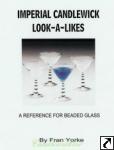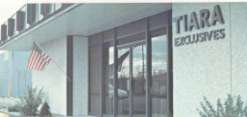
Help keep the database free, Buy from Amazon or donate today !!

Back to Database
        (Where we share books) Join us on Facebook  Promote Your Page Too |
From
the initial Bakewell & Ensell partnership to Bakewell, Page &
Bakewell to the final limited partnership of Bakewell, Pears & Co.
in the 1870's, the company was in business from 1807-1882. I've read
that the company was founded by Thomas Bakewell and Benjamin Page so
Ensell was probably an initial investor. The company was one of the
most important glass houses of the period equal to Boston &
Sandwich and the like. There was always some Bakewell family member at
the head of the company including Benjamin Page . In 1836, John Palmer
Pears became a partner.
In the early years, the company was famous for its cut and engraved glass that sold in almost all parts of the world and outside the US, particularly in Mexico. They manufactured about $200,000 annually of cut and engraved ware such as gas shades, goblets, decanters, tumblers; also tableware, bar furniture, chimneys, lantern glasses, and all kinds of blown and pressed glass.
Glass was produced as free-blown, mold-blown, and pressed in clear and colored. Decorative techniques included cutting, engraving, and cameo-incrustation (sulphides) were used. By 1845, Bakewell became the largest flint glass worksica making practically every type of glass.
One of the firm’s primary innovations was the cameo-incrustation or “sulphide” technique that had been perfected in English and French glass factories of the early nineteenth century. They utilized the sulphide process to produce remarkable mantel ornaments, decanters, plaques, tumblers, and knobs featuring encapsulated cameos (white clay portraits) of such leading political figures as Washington, Lafayette, and Franklin.
To attract a growing middle class market, the factory also offered well-made tableware and utilitarian forms. The ability to meet the needs of both ends of the market spectrum required innovative methods of shaping and decorating glass that set new artistic and production standards within the industry. Although the firm’s pressed glass was inexpensive, it attained a level of sophistication in design that equaled the finest examples from rival Massachusetts glasshouses.
NOTED FACTS & EVENTS in the companies History
References:
1. Old and Sold website from Antique Digest - Lost Knowledge from the past
2. http://www.blacktie-pittsburgh.com/
3. Wikipedia
In the early years, the company was famous for its cut and engraved glass that sold in almost all parts of the world and outside the US, particularly in Mexico. They manufactured about $200,000 annually of cut and engraved ware such as gas shades, goblets, decanters, tumblers; also tableware, bar furniture, chimneys, lantern glasses, and all kinds of blown and pressed glass.
Glass was produced as free-blown, mold-blown, and pressed in clear and colored. Decorative techniques included cutting, engraving, and cameo-incrustation (sulphides) were used. By 1845, Bakewell became the largest flint glass worksica making practically every type of glass.
One of the firm’s primary innovations was the cameo-incrustation or “sulphide” technique that had been perfected in English and French glass factories of the early nineteenth century. They utilized the sulphide process to produce remarkable mantel ornaments, decanters, plaques, tumblers, and knobs featuring encapsulated cameos (white clay portraits) of such leading political figures as Washington, Lafayette, and Franklin.
To attract a growing middle class market, the factory also offered well-made tableware and utilitarian forms. The ability to meet the needs of both ends of the market spectrum required innovative methods of shaping and decorating glass that set new artistic and production standards within the industry. Although the firm’s pressed glass was inexpensive, it attained a level of sophistication in design that equaled the finest examples from rival Massachusetts glasshouses.
NOTED FACTS & EVENTS in the companies History
- They were the first to manufacture flint glass successfully. Deming Jarves of Boston & Sandwich called Thomas Bakewell "the father of the flint-glass business in this country" in his Reminiscences of Glass-Making. In 1824, he visited the glass factory and 'paid special attention' while he was there.
- made high quality Sandwich Glass
- made a majority of the glass bureau knobs during the American Empire period
- in 1810, the first crystal chandelier produced in America. From a local paper at the time: "To Pittsburgh belongs the honor of producing the first cut glass chandelier in America—a six-light affair with prisms, cut in 1810 by a German named Eichbaum, who claimed to have been a glass cutter to Louis XVI of France, and after that unfortunate king's death came to Pittsburgh and established himself in business. The chandelier was suspended in the house of Mr. Kerr an innkeeper."
- In 1816, they presented President James Madison with a pair of magnificant cut and engraved decanters
- In 1817 they made cut and engraved decanters and glasses for the 1817 White House with the US Coat of Arms
- In 1825, a handsome pair of vases was presented to Lafayette during his visit to America when he said the glass was equal to the French which was highly prized at the time.
- 1832 President Jackson ordered a set of glass for his own use, to consist of bowls with and without stands, celery glasses, pitchers, decanters, tumblers, wine and champagne glasses, to be executed in best style of workmanship; the value of the order was estimated at $1,500. The firm previous to this had made for President Monroe a full set, and received a medal from the Franklin Institute as producers of the best work in cut glass.
- about 1850 they moved to between Eighth and Ninth streets on the South Side, Pittsburgh, PA
- a family member, John P. Bakewell, invented and patented the first known process for pressed glass in 1825, making possible mass production of glass for the first time.
- About pressed glass dolphin candlesticks
- Just when Bakewell Pears & Co. first produced dolphin pieces is not known; but by 1868 their chief Pittsburgh competitor, McKee & Brothers, had launched a similar design. In their catalog of that year is shown a small dolphin candlestick with a round base and another of the six-sided baluster design which they designated as “Boston candlestick,” possibly an unintentional tribute to the Boston and Sandwich Glass Company as the originators of this type. The prices quoted are dolphin candlesticks, $6.75 a dozen, and $7.50 for the other design. Also, I have seen a loop-and-petal candlestick of standard height in canary yellow glass that was made at the Portland, Me., factory.
References:
1. Old and Sold website from Antique Digest - Lost Knowledge from the past
2. http://www.blacktie-pittsburgh.com/
3. Wikipedia
Member Websites       |
Office Depot Coupons
DISCLAIMER
© Glass Lover Glass Database aka GLGD, 2006-2016, all rights reserved.
Copying material from these pages for reproduction in any format is expressly forbidden without permission.

